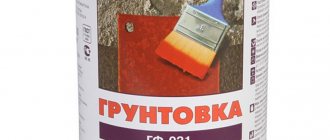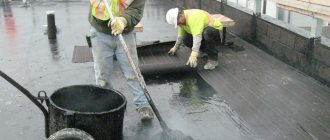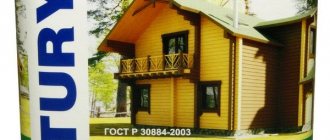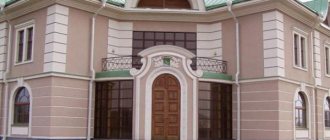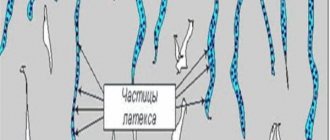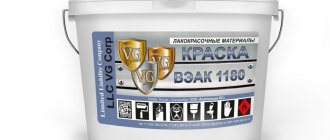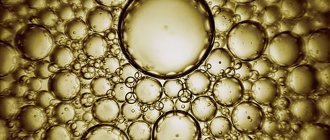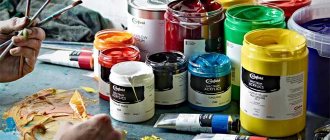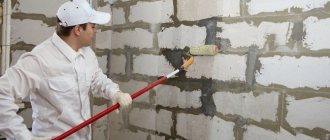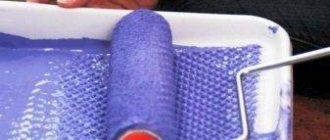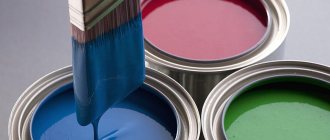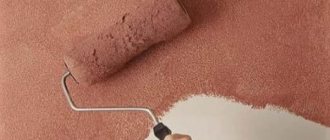GOST 28196-89
INTERSTATE STANDARD
WATER-DISPERSION PAINTS
TECHNICAL CONDITIONS
| Moscow Standardinform 2007 |
INTERSTATE STANDARD
| WATER-DISPERSION PAINTS Specifications Water-dispersion paints. Specifications | GOST 28196-89 |
Date of introduction 07/01/90
This standard applies to water-dispersion paints, which are suspensions of pigments and fillers in aqueous dispersions of synthetic polymers with the addition of various auxiliary substances (emulsifier, stabilizer, etc.).
The paints are intended for interior and exterior painting of buildings and structures on brick, concrete, plastered, wooden and other porous surfaces (except for floors), on primed metal surfaces, on old coatings, for painting fruit trees, ornamental trees, shrubs in order to increase their winter hardiness, protection from sunburn, protection from rodents and covering wounds.
Coatings based on water-dispersion paints VD-AK-111, VD-AK-111r, VD-KCH-183 retain protective properties no higher than score 2 according to GOST 9.407 in temperate climates for at least 5 years.
The coating based on water-dispersion paint VD-KCH-577 lasts on a young tree for 1 year, on a fruit-bearing tree for 2 years.
(Changed edition, Amendment No. 1).
BRANDS AND TECHNICAL REQUIREMENTS
1.1. Depending on the composition and purpose of the paint, the following brands are available:
VD-VA-224 - based on homopolymer polyvinyl acetate dispersion for indoor work, as well as rooms with high humidity (kitchens, bathrooms, toilets);
VD-KCh-26A, VD-KCh-26 - based on styrene-butadiene latex for indoor work (paint brand VD-KCh-26A - using titanium dioxide, paint brand VD-KCh-26 - lithopone);
VD-AK-111, VD-AK-111r - based on copolymer acrylate dispersion for external and internal painting of buildings and structures (VD-AK-111r is used to produce relief paint);
VD-KCh-183 - based on aqueous dispersions of synthetic polymers, for exterior painting of buildings and structures and interior finishing work (except for surfaces subject to intensive washing);
VD-KCh-577 - based on aqueous dispersions of synthetic polymers for painting fruit, ornamental trees and shrubs in order to increase their winter hardiness, protect against sunburn, protect against rodents and cover wounds.
1.2. Water-dispersion paints must be manufactured in accordance with the requirements of this standard according to recipes and technological regulations approved in the prescribed manner.
1.3. Characteristics
1.3.1. Paints must comply with the requirements and standards specified in table. 1.
Table 1
| Indicator name | Standard for brands | Test method | ||||||
| VD-VA-224 | VD-KCH-26A | VD-KCH-26 | VD-AK-111 | VD-AK-111r | VD-KCH-183 | VD-KCH-577 | ||
| OKP 23 1611 1001 | OKP 23 1621 0201 | OKP 23 1621 0101 | OKP 23 1631 0101 | OKP 23 1632 0243 | OKP 23 1621 0401 | OKP 23 1621 0500 | ||
| 1. Paint film color: | Must be within the permissible deviations established by the “Card Index” color samples (standards) or control color samples | According to clause 4.3 | ||||||
| white | Must be within the permissible deviations established by control samples | — | Must be within the permissible deviations established by control samples | |||||
| pale pistachio | — | — | — | — | 345, 346 | — | ||
| 2. Appearance of the film | After drying, the paint should form a film with a smooth, uniform matte surface. | According to clause 4.3 | ||||||
| 3. Mass fraction of non-volatile substances, % | 53 — 59 | 52 — 57 | 56 — 61 | 52 — 57 | 47 — 52 | 52 — 57 | 55 — 60 | According to GOST 17537 and clause 4.4 of this standard |
| 4. Paint pH | 6,8 — 8,2 | Not less than 9.0 | Not less than 9.0 | 8,0 — 9,0 | 7,5 — 9,5 | Not less than 8.0 | Not less than 6.5 | According to clause 4.5 |
| 5. Covering power of the dried film, g/m2, no more | 120 | 140 | 210 | 100 | 80 | 120 | 180 | According to GOST 8784, section. 1, 2 and clause 4.6 of this standard |
| 6. Resistance of the film to the static effects of water, at a temperature of (20 ± 2) °C, h, not less | 12 | — | — | 24 | 24 | 24 | — | According to GOST 9.403, method A and clause 4.7 of this standard |
| 7. Frost resistance of paint, cycles, not less | 5 | 5 | 5 | 5 | 5 | 5 | 5 | According to clause 4.8 |
| 8. Conditional light fastness (change in diffusion reflection coefficient), %, no more | — | — | — | 5 | 5 | 5 | — | According to GOST 21903, method 2 and clause 4.9 of this standard |
| 9. Degree of grinding, microns, no more | 30 | 70 | 70 | 60 | 60 | 60 | 60 | According to GOST 6589 |
| 10. Drying time to degree 3 at a temperature of (20 ± 2) °C, h, no more | 1 | 1 | 1 | 1 | 1 | 1 | 1 | According to GOST 19007 |
(Changed edition, Amendment No. 1).
1.3.2. Additional characteristics of paints are given in reference appendix 1.
(Introduced additionally, Amendment No. 1).
1.4. Packaging - according to GOST 9980.3.
1.5. Marking - in accordance with GOST 9980.4 with the application of a manipulation sign “Temperature Limitation” in accordance with GOST 14192.
(Changed edition, Amendment No. 1).
Characteristics of water-based paints according to GOST
GOST 28196 89 prescribes water-dispersion paints technical conditions that must be present in the manufactured product. Water emulsion can be used for a variety of purposes; different types of compositions are produced that differ in different properties.
To obtain a variety of properties and improve the paint, manufacturers add additional components. The basis can also be different elements, among them acrylic, which is known for its good properties. There are separate paints for facades and interior works. They are used for painting walls and ceilings. According to GOST, the characteristics of four types of paints are prescribed:
- VD VA 224, the maximum content of non-volatile elements in the composition varies from 53% to 59%. The ability to cover a surface with color is 120 grams per square meter of surface. Resistance to moisture is 12. pH ranges between 6.8 and 8.2. The maximum amount of freeze exposure is 5. Light resistance is not inherent. Complete drying under acceptable conditions lasts 60 minutes;
- VD AK 111, amount of non-volatile substances 52-57%, pH cannot be more than 9.5. The hiding power is approximately 100 grams per sq.m. Exposure to liquids is 24. Freezing is possible up to five times. Light resistance is five, drying takes 60 minutes;
- VD AK 111r. Non-volatile substances can be present at no more than 47-52%, pH varies from 7.5 to 9.5. Covering power is estimated at about 80 grams per m2. Moisture resistance -24. Resistance to freezing cycles and light fastness – 5. Drying lasts 60 minutes;
- VD CN 183 contains non-volatile elements in an amount of 52-57%. pH approximately 8. Coverage rate 120g/m2. Moisture resistance 24. Freeze up to five times. Light resistance 5, drying takes 60 minutes.
Water emulsion can be used for a variety of purposes; different types of compositions are produced that differ in different properties.
SAFETY REQUIREMENTS
2.1. Water-dispersion paints are fire and explosion proof.
2.2. During the production, testing and use of paints, fire safety and industrial sanitation requirements in accordance with GOST 12.3.005 must be observed.
2.3. All work with paint must be carried out in rooms equipped with supply and exhaust ventilation, ensuring the air condition of the working area in accordance with GOST 12.1.005.
2.4. The maximum permissible concentrations and hazard class of vapors of monomers and paint components are given in table. 2.
table 2
| Component name | Maximum permissible concentration, mg/m2 | Hazard Class | ||
| in the air of the working area of the production premises | in the water of reservoirs | in the atmosphere | ||
| Polyvinyl acetate dispersion: | ||||
| on vinyl acetate | 10 | 0,2 | 0,15 | 3 |
| by acetaldehyde | 5 | 0,2 | 0,01 | 3 |
| on dibutyl phthalate | 0,5 | 0,2 | — | 2 |
| Latex butadiene nitrile: | ||||
| for acrylonitrile | 0,5 | 2,0 | 0,03 | 2 |
| Styrene-butadiene latex: | ||||
| for styrene | 30/10 | 0,1 | 0,003 | 3 |
| Emulsion MBM-5s: | ||||
| by methyl methacrylate | 10 | 0,01 | 0,1 | 3 |
| for butalacrylate | 10 | 0,01 | — | 3 |
| for methacrylic acid | 10 | 1,0 | — | 3 |
| Ethylene glycol | 5 | 1,0 | — | 3 |
| Thiuram: (tetramethylthiuram disulfide) | 0,5 | 1,0 | 0,006 | 2 |
| Aerosil | 1,0 | — | — | 3 |
| Pentachlorophenolate | 0,1 | 5,0 | 0,001 | 1 |
| White Spirit | 300 | — | — | 4 |
| Titanium dioxide | 10 | — | — | 4 |
2.5. The harmful substances that make up the paint have a toxic effect on the hematopoietic organs, nervous system, skin, mucous membranes of the eyes and respiratory tract. The dried coating has no harmful effects on the human body.
2.4, 2.5. (Changed edition, Amendment No. 1).
2.6. Persons associated with the manufacture, testing and use of paints must be provided with special clothing and personal protective equipment in accordance with GOST 12.4.011 and GOST 12.4.103.
2.7. Monitoring compliance with maximum permissible emissions (MPE) into the atmosphere, approved in accordance with the established procedure, must be carried out in accordance with GOST 17.2.3.02.
Criteria for choosing water-based paint VEAC 1180
We learned that there are quite a few manufacturers of this type of paint. And hardware stores are filled with a variety of options. Some of them are cheap and unknown, while others are well-known and more expensive. It is clear that this matter is not worth saving. It is better to focus on proven material that has positive reviews and has proven itself well.
The main sign of a quality product is the presence of a certificate of conformity. If the store can provide it, then this is a good sign. What should be inside the certificate of water-based paint VEAC 1180? Such data:
- GOST marking.
- Address of the plant where the product was manufactured (legal and actual).
- List of surfaces for which water-based emulsion is suitable.
- The tests that the composition passed.
- The certificate is certified by the signature and seal of higher authorities.
Also, when purchasing, pay attention to the packaging itself. It should not be damaged, neither the label nor the can itself
Don't forget to check the expiration date. And remember, the most expensive does not mean that it is the best.
ACCEPTANCE RULES
3.1. Acceptance rules - according to GOST 9980.1.
3.2. Norms for indicators 5, 6, 8 table. 1 The manufacturer determines periodically once a month for at least three batches.
Norms for indicators 7, 9, 10 table. 1 The manufacturer determines periodically at the request of the consumer.
If the periodic test results are unsatisfactory, the manufacturer shall check each batch until satisfactory test results are obtained in a row of at least six batches.
3.1, 3.2. (Changed edition, Amendment No. 1).
TRANSPORTATION AND STORAGE
5.1. Transportation and storage - in accordance with GOST 9980.5. _______________ * The document is not valid on the territory of the Russian Federation. GOST 9980.5-2009 is in force. — Note from the database manufacturer.
5.2. Paints are transported at temperatures above 0 °C. Transportation is allowed at temperatures down to minus 40 °C, but for no more than 1 month.
Paints are stored in tightly closed containers in warehouses at temperatures above 5 °C.
(Changed edition, Amendment No. 1).
TEST METHODS
4.1. Sampling - according to GOST 9980.2.
4.2. Preparing samples for testing
Before testing, the paint is stirred and the mass fraction of non-volatile substances, pH, degree of grinding, and frost resistance are determined.
To determine other indicators, the paint is, if necessary, diluted with drinking water in accordance with GOST 2874* with a hardness (1/2 CaCl2) of no more than 7.0 mol/m3, condensate or distilled water in accordance with GOST 6709 to a viscosity of 20 - 30 s using a VZ-246 viscometer with a nozzle diameter of 4 mm (or VZ-4) at a temperature of (20.0 ± 0.5) °C when applied by pneumatic spraying or up to a viscosity of 40 - 80 s when applied with a brush. Then filter through mesh No. 1 according to GOST 6613 or two layers of gauze and apply to prepared according to GOST 8832, section. 3, records.
* GOST R 51232-98 is in force on the territory of the Russian Federation.
The color and appearance of the film, the resistance of the paint film to the static effects of water are determined on wooden plates measuring 50 ´ 100 mm, thickness 5 - 6 mm, conditional light fastness - on drawing paper in accordance with GOST 597 measuring 100 ´ 200 mm, hiding power and drying time - on glass plates for special purposes, size 90 ´ 120 mm, thickness 1.2 mm according to TU 21-0284461-058.
When determining the drying time, the paint is applied in one layer; when determining the color and appearance of the paint film, conditional light fastness, the paint is applied in two layers. When determining resistance to static water, paint is applied in two layers on both sides of the plate, as well as on the sides. Drying time between layers is 1 hour at a temperature of (20 ± 2) °C.
When determining hiding power, the second and subsequent layers are dried for 1 hour at a temperature of (20 ± 2) °C, then 1.5 hours at a temperature of (60 ± 2) °C and cooled for 0.5 hours at a temperature of (20 ± 2) °C.
The thickness of a single-layer film is 30 - 40 microns, two-layer - 60 - 80 microns. The thickness is measured with a micrometer type MK 25-1 according to GOST 6507 or another type of device with an error of no more than ± 3 µm.
Before testing according to indicators 6, 8 of table. 1 film is kept for 48 hours at a temperature of (20 ± 2) °C and a relative humidity of 60 - 70%, for indicator 1 - for 2 hours at a temperature of (20 ± 2) °C.
(Changed edition, Amendment No. 1).
4.3. Determining the color and appearance of the paint film
The color of the dried paint film is determined by visual comparison with the color of the corresponding samples (standards) of the “Card Index” color or control color samples in natural or artificial daylight diffused light. The samples to be compared should be in the same plane at a distance of 300 - 500 mm from the observer’s eyes at a viewing angle that excludes surface gloss.
The appearance of the dried paint film is determined visually in natural or artificial daylight.
In case of disagreement in the assessment of color and appearance, the determination in natural daylight is taken as the final result.
4.4. The mass fraction of non-volatile substances is determined according to GOST 17537, a sample of paint is dried at a temperature of (105 ± 2) °C for 40 minutes.
4.5. Determination of paint pH
4.5.1. Instruments, reagents and materials
pH meter with glass electrode, measurement error no more than 0.1 pH.
Glass glass V-2-50 according to GOST 25336.
Hydrochloric acid according to GOST 3118, solution with a mass fraction of hydrochloric acid of 3%.
Distilled water according to GOST 6709.
4.5.2. Carrying out the test
The paint is poured into a glass with a capacity of 50 cm3, thoroughly washed with distilled water, and the pH is determined. A new glass must be pre-treated with a hot solution of hydrochloric acid, and then rinsed thoroughly with distilled water.
4.5.3. Processing the results
The result of measuring paint pH is taken to be the arithmetic mean of the results of two parallel determinations, the absolute discrepancy between which should not exceed the permissible discrepancy of 0.1 pH.
The measurement result is rounded to the first decimal place.
The permissible total error of pH determination results is ± 0.1 with confidence probability P
= 0,95.
4.6. Determination of the hiding power of the dried film - according to GOST 8784, section. 1 or sec. 2. In case of disagreement in the assessment, the determination of hiding power by the instrumental method is taken as the final result.
4.6.1. Instrumental method for contrast ratio - according to GOST 8784, section. 2 with the following additions.
4.6.1.1. Carrying out the test
On a glass plate prepared according to GOST 8832, section. 3, measured (length, width) and weighed, apply one or two layers of paint.
The plate with the applied paint is alternately placed on a black or white plate and the brightness coefficients are measured at a wavelength of 560 nm (or a green filter at a wavelength of 560 nm) at four points on the film. The brightness coefficient is determined in accordance with the instructions for the optical device used for this determination.
The plate with the paint film is weighed and the contrast ratio ( C
):
where R
1,
R
2 - brightness coefficients when applying a plate with a film of paint to the black and white plates, respectively.
The result of measuring the contrast ratio is taken to be the arithmetic mean of the results of four parallel determinations, the discrepancy between which should not exceed the permissible discrepancy of 0.02.
The final result is rounded to the second decimal place.
If the contrast ratio is less than 0.98, apply another layer of paint and repeat the determination of the contrast ratio.
If the contrast ratio is more than 0.99, the determination is repeated, applying a smaller amount of paint to the plate.
With a contrast ratio of 0.98 to 0.99, the hiding power value is calculated.
4.6.1.2. Processing the results
Coverage index ( D
), g/m2, calculated by the formula
where m
1—weight of the plate with the dried paint film, g;
m
0—mass of unpainted plate, g;
106 is the coefficient for converting the area dimension from mm2 to m2;
S—
plate area, mm2.
For glass plates measuring 90 ´ 120 mm, the ratio is 106 / S
equals 92.6.
The result of measuring hiding power is taken as the arithmetic mean of the results of two parallel determinations, the discrepancy between which should not exceed the permissible discrepancy of 6 g/m2. The final result is rounded to the nearest whole number.
Permissible total error of the measurement result ± 4 g/m2 with confidence probability P
= 0,95.
4.6 - 4.6.1.2. (Changed edition, Amendment No. 1).
4.7. The resistance of the film to the static effects of water is determined according to GOST 9.403, method A.
After testing, the samples are kept before inspection at a temperature of (20 ± 2) °C for 3 hours.
Lightening of the paint film is allowed.
4.8. Determination of frost resistance of paint
4.8.1, 4.8.1.1 - 4.8.1.3 (Deleted, Amendment No. 1).
4.8.2. Method 2
4.8.2.1. Measuring instruments, auxiliary devices, reagents and materials
Refrigerating chamber providing a temperature of minus (40 ± 2) °C.
Thermometer in accordance with GOST 28498 with measurement limits from minus 90 to 30 °C and a division value of 1 °C.
Metal can according to GOST 6128 or polyethylene.
Glass plate.
Glass rod.
4.8.2.2. Carrying out the test
A metal can is filled halfway with paint, closed with a lid and placed in a refrigerator, where it is kept for 6 hours at a temperature of minus (40 ± 2) ° C, after which the can is left for 18 hours at room temperature. The cycle is repeated five times.
Then the paint is mixed and its resistance to coagulation is visually determined by evenly distributing the paint with a glass rod over a glass plate (test glass). Paint that has not been tested for frost resistance is also applied to a glass plate (control glass). The control and test glass are compared with each other.
Paint is considered frost-resistant if, after five freeze-thaw cycles, no hard lumps appear in a thin layer of paint.
(Changed edition, Amendment No. 1).
4.9. Conditional light fastness is determined according to GOST 21903, method 2.
From the middle part of three paints, prepared as specified in clause 4.2 of this standard, one sample measuring 50 ´ 50 mm is cut out. The paint sample is placed for 24 hours under the lamp at a distance of (250 ± 5) mm from it. After exposure under the lamp, the paint is kept for 2 hours in a dark place at a temperature of (20 ± 2) °C before taking measurements.
4.10 When carrying out measurements and tests, it is allowed to use other measuring instruments and laboratory glassware with similar metrological characteristics.
DIRECTIONS FOR USE
6.1. Before use, if necessary, defrost the paint at a temperature of (20 ± 5) °C. mix thoroughly and dilute with water in accordance with clause 4.2 of this standard. The paint is applied to prepared according to GOST 8832, section. 3, surfaces by brush, roller or air spray.
6.2. Paints of the brands VD-VA-224, VD-KCh-26A, VD-KCh-26, VD-AK-111, VD-KCh-183 are applied to the surface in two layers, paints of the brands VD-AK-111r and VD-KCh- 577 - in one layer.
Paint consumption per layer, g/m2:
VD-VA-224, VD-KCH-26A, VD-AK-111, VD-KM-183 - 110 - 150;
VD-AK-111r - 250 - 300;
VD-KCH-26 - 150 - 200.
The average consumption of VD-KCh-577 paint for a young tree is 30 - 40 g, for a fruit-bearing tree - 150 g.
6.1, 6.2. (Changed edition, Amendment No. 1).
6.3. The old indoor coating must first be washed with water and soap or washing powder, an ammonia solution or a 3% soda solution (1 tablespoon per 1 liter of water), and then with clean water.
Surfaces previously coated with chalk or lime paints must be thoroughly cleaned until completely removed.
Any loose outer covering must be completely removed.
Tinting of white paints with water-based pigment pastes is allowed.
6.4. VD-KCH-577 paint is applied in the autumn (before the leaves fall) and early spring periods at ambient temperatures above 0 °C. Wounds on trees are covered with undiluted paint in the spring and summer.
6.5. To obtain relief paint, a coarse filler is introduced into the VD-AK-111r paint before use - sand in accordance with GOST 8736 in a ratio of 2:1 by weight. Mix the paint thoroughly.
6.6. Water-dispersion paints for exterior use should be used at an ambient temperature of at least 8 °C.
If the temperature is below 15 °C, it is allowed to increase the drying time of each layer of paint to 24 hours.
6.7. The method of using water-dispersion paints intended for retail trade is given in Appendices 2, 3.
Working with paint
Painting a wall yourself with acrylic water dispersion is not difficult, but to obtain a flawless result, it is important to properly prepare the surface for finishing. The degree of complexity of this task always depends on the initial state of the walls or ceilings
Preparation
- Wash and clean off all dirt.
- If there is an old coating and its condition leaves much to be desired (cracks, bubbles, peeling layer), then all this must be removed using a spatula or scraper. In particularly difficult cases (oil paint on concrete), a hair dryer, a drill with an attachment in the form of a crown or a wire brush is used; you can also purchase a special product for removing old paint (removal). We also recommend that you read more about the question of whether acrylic paint can be applied to oil paint.
- Existing flaws (cracks, chips, potholes) need to be covered with putty, wait until dry, and smooth out the unevenness with fine-grain sandpaper.
- Clean the surface completely from dust and coat it with a layer of primer. It’s good if it contains an antiseptic; this will create additional protection against mold and other harmful microorganisms.
Painting
To work with water-dispersion paint, a spray bottle is often used. Using this tool you can significantly speed up the process, but it is quite possible to get by with a set of the simplest devices:
- paint brushes and roller,
- tray,
- masking tape.
Paper adhesive tape is used to protect surfaces that are not to be painted or to mark boundaries between areas that are painted in different shades.
The material is first applied with a brush to hard-to-reach places: corners, joints, etc. To start working with a roller, its coat must be thoroughly soaked with a coloring agent, and then the excess must be removed by rolling it along the special ribbed surface of the tray.
The wall is painted by rolling the roller up and down and left and right alternately, thus applying the most uniform and high-quality first layer. When it dries, they follow the same principle a second time, but now things will go faster, and paint consumption will be reduced by almost a third.
Two layers are usually enough to obtain an even and rich tone, but if desired, you can add a third. It is possible to diversify the decor using textured rollers, stencils and other devices.
Acrylic water-dispersion paint is a very convenient material for realizing creative ideas for improving the interior and updating facades.
ANNEX 1
Information
additional characteristics
Reflection coefficient at an angle geometry of 0 - 45° of film for paints VD-VA-224, VD-AK-111, VD-KCh-183, VD-KCh-26A, VD-KCh-26 - no less than 82%, VD-KCh -577 – at least 75%.
The elasticity of the film when bending is 1 mm.
The mass fraction of residual styrene for VD-KCh-26A and VD-KCh-26 paints is no more than 0.03%.
Paint film washability, no more than:
VD-VA-224, VD-KCh-577 - 3.0 g/m2;
VD-KCh-26A, VD-KCh-26, VD-KCh-183 - 3.5 g/m2;
VD-AK-111, VD-AK-111r - 2.0 g/m2.
Conditional viscosity of paint according to a VZ-246 viscometer with a nozzle diameter of 4 mm at a temperature of (20.0 ± 0.5) °C is at least 30 s.
(Changed edition, Amendment No. 1).
WATER-DISPERSIVE PAINT
__________________________________
(brand)
Purpose
Paint ………………… (brand) is intended for ………….. (from the introductory part and clause 1.1 of this standard).
Mode of application
The surface preparation method is in accordance with Section. 6 of this standard and depending on the purpose of the paint.
Before use, the paint is thoroughly mixed and, if necessary, diluted with water and filtered through two layers of gauze.
The paint is applied to the prepared surface with a brush, roller, or spray gun in two layers with intermediate drying for 1 hour at a temperature of 18 - 22 ° C.
Paint consumption for a single-layer coating is …………….. (Section 6 of this standard).
Paint tinting with aqueous pigment pastes is allowed.
Wash tools, containers, stains with warm water and soap until the paint dries.
Store the paint in a tightly closed container at temperatures above 0 °C. It is allowed to store paint at temperatures down to minus 40 °C for no more than 1 month. If frozen, the paint should be thawed at room temperature and mixed until smooth.
Guaranteed shelf life - 12 months.
Precautionary measures
The paint is fire and explosion proof.
Do not mix with other paints or thinners.
(Changed edition, Amendment No. 1).
How to get a dirt-repellent coating?
If you have asked yourself this question, then you will solve this problem by reading the article to the end. The dirt-repellent coating will allow you to wash painted surfaces less often and will also simplify this task. You can get this effect thanks to the Aqualite water repellent.
A surface coated with such a material has repellent, bactericidal properties, as well as the “effect” of a lotus.
The Aqualite company guarantees the quality of products in unopened packaging for 12 months from the date of manufacture. The service life of the coating, subject to application technology, is 8 years.
The paint is packaged in plastic buckets of 25 kg, 20 kg, 14 kg, 12 kg, 7 kg, 3 kg, and also, if necessary, in metal containers. Our specialists will help you make the right choice, as well as choose the color, call us and get a free consultation.
